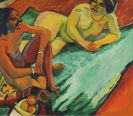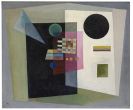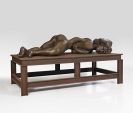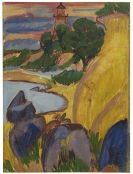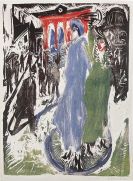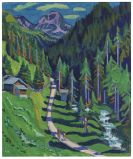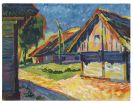
Werner Scholz
Berlin
1898 -
Schwaz/Tirol
1982
The 17 years old Werner Scholz volunteered for the army directly after school - a decision with consequences that left their mark on his entire personality. He lost his left forearm by a shell in 1917. His war experiences and the social misery of the city that Scholz encountered after the war when he was at the Hochschule der "Bildenden Künste" in Berlin, mainly found expression in black-and-white depictions in his early works, which were soon appreciated by artistic circles and critics. When he left the academy in 1920 and moved into his own studio, he was interested in the Brücke-painters and Emil Nolde, who also impressed by Scholz's works.
At the end of the 1920s socially committed oil paintings of Berlin's city environment emerged, before Scholz devoted himself to some triptychs, of which the majority was lost without a trace. In 1930 the "Nationalgalerie Berlin" and the "Wallraf-Richartz Museum" in Cologne purchased pictures of the artist.
From 1933 on the Nazis made public exhibitions more difficult for him or even stopped them, but Scholz continued to work in Berlin and Alpbach/Tyrol. In 1937 the artist was banned from exhibiting. The Nazis displayed two of his pictures at the exhibition "Entartete Kunst". When his studio in Berlin was destroyed by bombs, Scholz moved to Alpbach for good.
After the war Werner Scholz dealt with topics such as the apocalypse, the old Testament and the Greek Mythology, which he depicted in pastel cycles. The first exhibitions after 1946 showed his creations in many German cities. Scholz consequently followed the way he pursued in the 1920s: His articulateness in painting, which had its roots in German expressionism, got a serious and often melancholic undertone through a dark coloration.
In 1954-55 Scholz painted the "Steel-triptych" by order of Krupp, which was followed by a large number of pictures of the industrial world of the Ruhr area.
From 1957 until 1966 large-format landscapes arose as a result of his frequent trips to South Tyrol and Northern Italy. Scholz's last pictures - people, nudes and landscapes - were painted in his studio in a former cloister in Rott near Wasserburg on the Inn in 1978.
Werner Scholz died in Schwaz/Tyrol on 5 September 1982.
Would you like to sell a work by Werner Scholz?
Infos for seller
